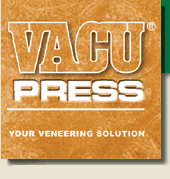Don Stephan

Posts: 825
Joined: 2003-07-18
Location: Cincinnati, Ohio
 User Profile User Profile |
The grooves in the platen are to provide a way for the air in the bag to reach the vacuum hose. They should run both the length and width of the platen. If they are 1/8" or so deep, less likely to be blocked by occasional drop of glue squeezeout. The grooves would mar the workpiece, so a bottom caul is placed on top of the platen. It should be at least as long and wide as the workpiece, but can be longer and wider. The bottom caul can be as thin as 1/4" as the platen is (or should be) very stiff and flat. Ideally the bottom caul is coated to keep glue from sticking, but you could alternatively wrap the workpiece with 4-6 mil plastic. If using sheet of plastic, BE SURE plastic does not fold back on itself or wrinkle on either side of the workpiece as the extra thickness will dent the surface of the workpiece.
If only veneering one side of the workpiece at a time, don't need a top caul. If veneering both at once, the top caul can be as thin as 1/4", again melamine or similar coating is an advantage. Top caul should extend about 1/8" beyond all four edges of the workpiece. If longer and/or wider, the vacuum will try to break off the overhang and/or flex the top caul.
If using multiple pieces of veneer (i.e. marquetry) on a surface, quite possible there will be differences in veneer thickness. A compressible pad is recommended in those cases to even out the pressure so all pieces of veneer tight against the substrate. Many people use single layer of thick canvas. I've used rubber roofing if I can avoid the seams in the roofing; several people have used a different type of rubber sheet - try a search on this forum to find description.
A couple videos on vacuum veneering are highly recommended - there is some overlap between the two but there are some unique explanations on each. One is available at www.vacupress.com, the other at www.schurchwoodworking.com. If interested in veneering curves, the 2nd at vacupress.com is recommended; if interested in marquetry the 2nd at schurchwoodworking is recommended (although I haven't seen it yet).
You're also welcome to download a compilation of tips, suggestions, explanations, et cetera that I've collected over the years. www.stephanwoodworking.com and at the bottom of the home page click "downloadable files that may be of interest to woodworkers." On that page click either form of the veneering notes.
|






